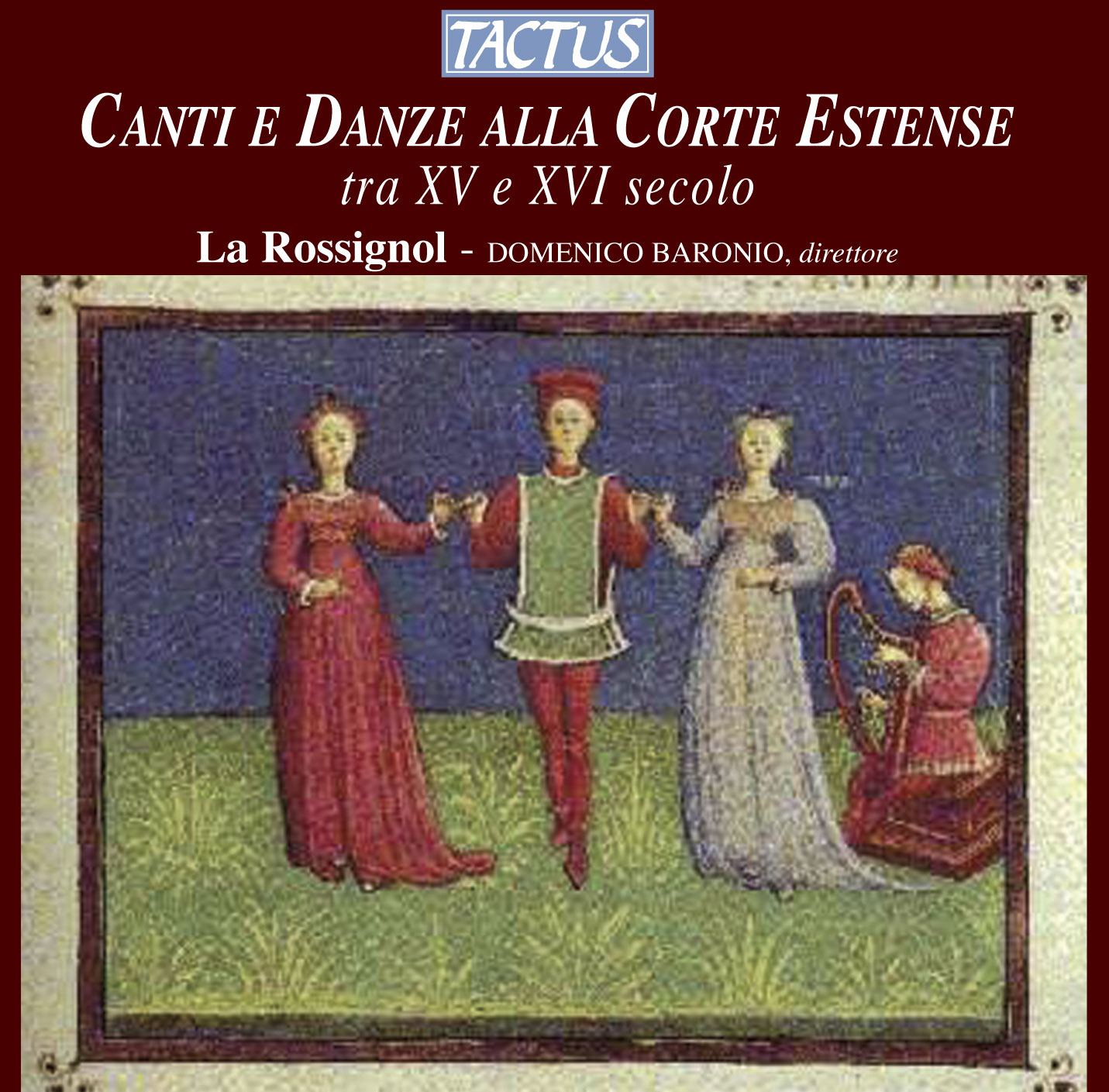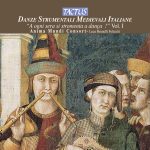Pierre Attaignant, Domenico da Piacenza, Van Ghizighem, Antonio Capriolo da F. Bossinensis, Guglielmo Ebreo, Marcantonio Del Pifaro, Frate Gerardo, Domenico da Piacenza, Anonimo da Bossinensis, Giovanni Ambrosio, Pierre Phalèse, Joanambrosius Dalza
The 15th century saw the birth and multiplication of musical venues and performances which fell outside the direct control of the Church. This evolution led to new tastes and artistic figures, in particular that of the musician, who often enjoyed great notoriety and was elevated to the level of a professional, and the newer figure of the “maestro di ballare”. This was a time when polyphonic masterpieces (such as those of the Flemish school) cohabited with simpler compositions, often tied to local traditions. In the case of the latter, music was conceived as an overflowing of the words themselves, similar to the repertoires of oral tradition. One such genre which drew particular attention was that of the frottola. Dance collections were also widespread. The humanistic culture produced an art which was refined, elegant, codified, and written out in precise forms by great masters. Domenico da Piacenza (from Ferrara), the humanist Antonio Cornazano, and Guglielmo Ebreo da Pesaro (who converted to Christianity and took the name of Giovanni Ambrosio) were the first and some of the most interesting authors of manuscript treatises on the art of dancing. Sought-after organizers and animators of feasts, banquets and receptions celebrating visits by kings and princes, engagements, weddings, diplomatic missions and military conquests all played a part in the education and moral instruction of the nobility. Music and dance, as Baldasar Castiglione states in his “Libro del cortegiano”, were necessary requisites for the proper training of a lady and a courtier. The natural context for the dance was the “festa”, that is to say, a complex ensemble of multiple actions (tournaments, banquets, and dynastic celebrations), characterized by many signs, gestures and allegories based upon mythology which constituted a recognized code for the spectators of the time. In this way, rulers manifested their magnificence, for by the grandeur of the events, they celebrated their own triumphs and earned the admiration and respect of all who witnessed the events: sovereign friends and foes, ambassadors, men of culture, noble artists and the common people. One of the richest and most florid Italian courts in the field of music and dance was certainly that of Ferrara, which hosted the most noted musicians and dance masters of the period. Leonello Borso, his daughters Isabella and Beatrice, his son Alfonso I and Lucrezia Borgia were among the most eminent figures of the Renaissance. Their mastery of the art of dancing became the object of great admiration in contemporary chronicles and accounts by ambassadors and writers, and is confirmed by the great popularity of such “Ferrarese” dances as Il Leoncello (written for the wedding of Leonello D’Este), La Marchesana, La Rosina, and others.
Tracklist
Disco n.1
Guglielmo Ebreo da Pesaro,
Anello
1 - Anello (1:53)
Anonymous
L'amor dona ch'io te porto [MS Italiano di frottole, BN Parigi, Res Vm7 676]
2 - L'amor dona ch'io te porto [MS Italiano di frottole, BN Parigi, Res Vm7 676] (2:24)
Attaingnant, Pierre
3 - Tourdion (3:05)
Piacenza, Domenico da
4 - De arte saltandi e choreas ducendi: Lioncello (2:57)
van Ghizeghem, Hayne
5 - De tous bien plaine (4:23)
Guglielmo Ebreo da Pesaro,
6 - Amoroso (1:49)
Anonymous
7 - J'ay pris amours [Glogauer Liederbuck] (1:12)
Caprioli, Antonio
8 - Quella bella e biancha mano (3:56)
Guglielmo Ebreo da Pesaro,
9 - Bassadanza cupido (2:02)
Pifaro, Marc'Antonio
10 - Intabolatura de lauto, Book 1: Chiaranzana (3:04)
Anonymous
11 - Deh fussi la cui meco [MS Italiano di frottole, BN Parigi, Res Vm7 676] (1:46)
Gerardo, Frate
12 - L'altra notte m'insognava (1:44)
Piacenza, Domenico da
13 - La figlia Guilielmino (2:23)
Anonymous
14 - Dolce amoroso foco [Tenori e contrabbassi, 1511] (after Bossinensis) (2:51)
Guglielmo Ebreo da Pesaro,
15 - De voltate in ca (2:25)
Phalèse, Pierre
16 - Liber Primus Leviorum Carminum: Pavane et Gaillarde Ferrarreze (6:03)
Anonymous
17 - Sergonta Bergonta [MS Italiano di frottole, BN Parigi, Res Vm7 676] (2:10)
Dalza, Joan Ambrosio
18 - Intabolatura de lauto, Book 4: Piva (2:57)
Anonymous
19 - O tiente alora [MS Italiano di frottole, BN Parigi, Res Vm7 676] (3:07)
- Composer: Pierre Attaignant, Domenico da Piacenza, Van Ghizighem, Antonio Capriolo da F. Bossinensis, Guglielmo Ebreo, Marcantonio Del Pifaro, Frate Gerardo, Domenico da Piacenza, Anonimo da Bossinensis, Giovanni Ambrosio, Pierre Phalèse, Joanambrosius Dalza
- Performers: La Rossignol: Roberto Quintarelli, contraltista · Erica Scherl, vielle, percussioni
Matteo Pagliari, flauti, traversiere, schreyerpfeifen, bombarda · Lucio Testi, bombarde,
ciaramelli, schreyerpfeifen, cromorni · Fedele Stucchi, trombone a tiro rinascimentale
· Claudio Demicheli, spinetta, cornamusa, ghironda, percussioni
Domenico Baronio, liuto, cister, chitarrino, direttore - Historical Period: Middle Ages
- Code: TC 400003
- Edition: September 2003
- Barcode: 8007194102697
- Set: 1
- Total tracks: 19
- Total duration: 00:52:02
- Texts: Songs and Dances at the House of Este in the 15th and 16th centuries






